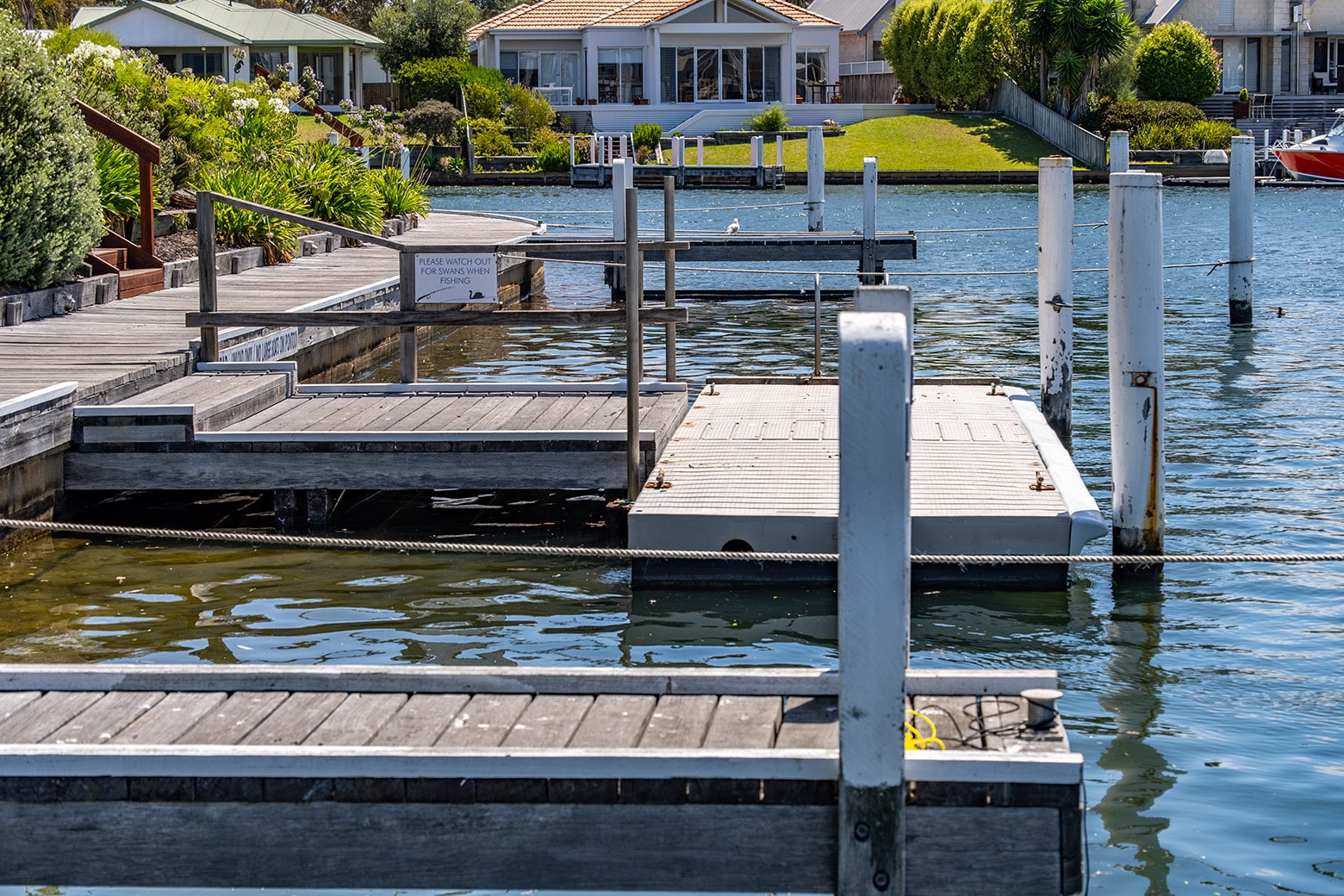
Marine Decking: What Makes It Different (And When You Need It)
If you’re building anywhere near the water—salt, fresh, or brackish—your decking can’t be standard. It has to be marine-grade.
Whether you’re outfitting a commercial marina, private boat dock, or lakeside boardwalk, marine decking materials are engineered to perform in ways that standard outdoor decking just can’t. These products are built to resist water absorption, UV degradation, mold, and damage from marine organisms, all while handling heavy traffic and constant exposure to the elements.
In this guide, we’ll break down what makes decking truly marine-grade. We’ll also explore how it differs from conventional wood and composite flooring, when it’s necessary, and which materials rise to the occasion for performance, safety, and style to help you make the most intelligent decision for your waterfront build.
How is Marine Decking Different Than Other Outdoor Flooring Solutions?
Not all outdoor decking is designed to withstand the harsh conditions of a marine environment. You also need to consider high-traffic areas for pedestrians, boat cargo, and other purposes.
Marine-grade materials are tested and trusted to resist:
- Constant exposure to moisture (not just rain, but high humidity and standing water)
- Salt air, marine life, and corrosive environments
- UV rays, high temps, and freeze/thaw cycles
- Heavy pedestrian loads, boating gear, and cargo
Unlike standard wood or vinyl options, marine decking must also meet higher standards for structural stability, slip resistance, and fastener compatibility.
When Is Marine Decking Necessary?
Not every project calls for marine-grade materials, but many do.
You probably need marine decking if:
- Your build sits directly on or over water (like docks or piers).
- You’re near the ocean, intercoastal, or high-humidity region.
- You need a non-slip surface for pedestrian safety.
- You want decking that resists swelling, mold, or rot without constant upkeep.
- You’re building a dock, pier, seawall cap, or boat lift platform.
- You want long-term durability without the need for frequent repairs.
- Heavy pedestrian and cargo loads, especially in marinas and piers.
You might get away with traditional decking if:
- You’re building inland with zero salt exposure.
- Your deck is elevated and protected from splash zones.
- You’re on a tight budget and willing to perform regular maintenance.
But even if it’s not mandatory, marine decking is always a smart long-term move around the water. If you have ever lived in a coastal environment, you probably already realize that salt doesn’t need to touch a deck board to do damage—salt air travels.
Advantages of Marine vs. Standard Decking Materials
It’s easy to think that any outdoor decking can work by the water. But here’s how marine decking is a standout from traditional decking.
| Feature | Marine Decking | Standard Decking |
| Water Resistance | Built for constant exposure, splash zones, and even submersion. | Handles only light rain; not suitable for saturated or submerged environments. |
| Durability | Engineered to withstand heavy wear, pressure, and extreme weather conditions. | Degrades faster under harsh weather or continuous use. |
| Hardware | Requires 316 stainless steel or marine-grade corrosion-resistant fasteners. | Typically uses galvanized or coated screws that may corrode in salty air. |
| Upfront Cost | Higher initial investment, but offers long-term value through durability and fewer repairs. | Lower initial cost, but ongoing maintenance and repairs increase total cost. |
| Maintenance | Requires less upkeep in harsh or marine environments. | Needs regular sealing, staining, and frequent inspection. |
Your Marine Decking Criteria Checklist
What kinds of features should you look for when shopping for marine flooring materials? Here’s your checklist!
- Water and Salt Resistance: True marine decking resists swelling, warping, rot, and corrosion caused by salt and constant water contact.
- Structural Integrity: It must remain stable under constant stress, both environmental and mechanical.
- Material Treatments: Marine-grade lumber is often pressure-treated with specific chemicals like MCA (Micronized Copper Azole) to resist rot and marine borers. Composite and PVC options are engineered to resist fading, warping, and mold.
- Hardware Compatibility: Marine decking often requires 316 stainless steel or hot-dip galvanized hardware to prevent fastener failure from corrosion.
- Certification and Ratings: Certain materials are rated or approved by local building codes or marine authorities, particularly for commercial applications.
Popular Marine Decking Materials
There’s no substitute for high-quality materials when it comes to functionality and a durable surface for all your decking needs. Decks & Docks stocks only the best brands in marine decking to fit all needs and budgets:
- Composite Decking: Durable, water-resistant boards made from recycled wood and plastic. Low-maintenance and splinter-free. Great composite decking brands include Trex, Fiberon, TimberTech, and Owens Corning WEARDECK™, just to name a few.
- PVC Decking: 100% synthetic and fully waterproof. Resists mold, rot, and salt. Ideal for high-exposure docks. TimberTech’s advanced PVC line is a top choice.
- Pressure-Treated Lumber: Natural wood treated for rot and termite resistance. Pressure-treated lumber is affordable and strong, especially in products like Decks & Docks’ Marine Deck. Requires sealing and marine-rated fasteners.
- Aluminum Decking: Lightweight, rust-proof, and fade-resistant. Perfect for commercial dock floats and ramps, railings, dock ladders, and fencing. Very low maintenance.
- Tropical Hardwoods (Ipe, Garapa, Cumaru): Extremely dense and naturally resistant to water, insects, and salt. Hardwoods offer a premium look and durability. Needs annual sealing to maintain color.
Installation Considerations Unique to Marine Decking
Marine projects come with specific challenges. Here’s what to keep in mind:
- Fasteners: Use 316 stainless steel or approved marine-grade fasteners to prevent corrosion.
- Deck Ventilation: Choose open or grated options like ThruFlow to promote airflow and prevent moisture buildup under the deck.
- Spacing: Materials expand and contract with changes in temperature and humidity—especially composites. Follow the manufacturer’s gap specs.
- Permits: Marine builds often require permitting from local or federal environmental agencies.
- Substructure: Pressure-treated marine-grade lumber is often used for framing, even under composite or PVC decking. That said, Owens Corning makes great composite structural lumber.
- Tide and Flood Zones: Ensure materials and layout meet code for wave action or flood-prone areas.
Decks & Docks has experts on staff who can help you plan for these variables.
Maintenance Requirements for Marine Decking
Maintenance varies based on the material, but marine-grade decks do require some upkeep due to wear and tear.
Composite & PVC
- Rinse periodically to remove salt buildup.
- Clean annually with mild soap and water.
Pressure-Treated Lumber
- Seal and stain every 6–12 months.
- Regularly inspect for rot, fastener corrosion, and warping.
Aluminum
- Minimal maintenance. Just occasional rinsing is all you need to do, and you’re good to go!
Tropical Hardwoods
- Annual sealing to preserve color and resist graying in direct sunlight.
- Clean with specialized wood cleaners.
The more extreme your environment, the more consistent your maintenance should be.
Is Marine Decking Worth the Investment?
Short answer: yes, if you’re anywhere near saltwater.
While marine-grade materials carry a higher upfront cost, they pay for themselves through a longer lifespan, lower maintenance costs, fewer repairs and replacements, and better safety and structural integrity. Plus, they protect your time, energy, and the value of your property. Decks that fail early aren’t just a hassle; they’re also expensive liabilities.
Need Help Choosing Marine Decking for Your Build?
Trust the Marine Construction Experts at Decks & Docks!
At Decks & Docks, we live and breathe marine construction and everything for outdoor spaces. Our inventory is packed with the industry’s best decking options, with PVC, composite, aluminum, hardwood, and everything in between. More importantly, our team can advise on what works for your exact environment.
We offer fast delivery, expert advice, and trusted brands that can handle anything salt, sun, or surf throws at them.
Contact us today, shop online at our partner The Deck Store, or visit one of our many locations from coast to coast.
Deck it. Dock it. Do it right.
Marine Decking FAQs
What’s the best marine flooring for boats and marinas exposed to fish blood and saltwater?
Composite and PVC decking are top choices for marine and boat flooring thanks to their non-absorbent nature and stain resistance. They stand up to fish blood, salt, and heavy use without absorbing moisture or odors.
Which marine decking options offer the best non-slip surface?
Textured PVC provides excellent non-slip protection, even when wet. For boat decks and docks, patterns like brushed or diamond grip help increase surface traction and prevent slips near the bow or stern.
Can marine decking help with noise reduction on personal watercraft?
You bet! EVA foam, in particular, is excellent at damping noise and vibrations from engine and hull contact. This enhances your boating experience by reducing rattles and creating a smoother ride—especially important for small vessels like jet skis.
How does marine flooring improve safety on boats and docks?
Non-slip surfaces, such as textured PVC, reduce the risk of slips and falls, even when wet. Cushioning materials also help absorb shock, keeping boaters safer during impact or turbulence.
What flooring solutions are best for boats and docks that see heavy foot traffic?
Composite marine decking and high-quality PVC are both durable options. Both deck board styles resist stains and wear. Choose based on your vessel type and how often you maintain your flooring.
Can I install marine flooring myself, or should I hire a pro?
Many products are DIY-friendly. Still, proper installation depends on surface prep, layout, and securing edges. If you’re unsure how to install or maintain it long-term, it’s worth consulting our marine flooring experts at Decks & Docks for some pointers, or we can help you find some local professional sources.
What should customers expect when shopping for marine flooring from Decks & Docks?
Quality, durability, and tailored solutions. From marine decking to other non-slip options, right down to the nuts and bolts, we stock only trusted brands as your one-stop shop for everything decks and docks. Our team helps boaters find the right style, size, and features to match their vessel and budget. You’ll get expert advice, quick delivery, and flooring that’s built to perform.
- About the Author
- Latest Posts
Dan has worked for Decks and Docks for over twenty-five years. He managed the original Decks and Docks store in St. Pete, which is our largest store. Dan is simply the best all around. He knows more about this company and our products than probably anyone else. Dan currently works in Sales at our corporate office.
